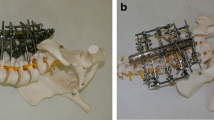Abstract
Purpose
The aim of the study was to evaluate clinical and radiographic outcome of patients treated with a modified Grob technique analysing the advantages related to increased mechanical stability.
Methods
30 patients that underwent “in situ” fusion for L5-S1 spondylolisthesis were evaluated. All patients presented a low-dysplastic developmental L5-S1 spondylolisthesis. Patients were divided into two groups: A, in which L5-S1 pedicle instrumentation associated with transsacral screw fixation was performed, and B, in which L5-S1 pedicle instrumentation associated with a posterolateral interbody fusion (PLIF) was performed.
Results
Patients treated with transdiscal L5-S1 fixation observed a faster resolution of the symptoms and a more rapid return to daily activities, especially at 3–6 months’ follow-up. The technique is reliable in giving an optimal mechanical stability to obtain a solid fusion.
Conclusions
The advantages of this technique are lower incidence of neurologic complications, speed of execution and faster return to normal life.






Similar content being viewed by others
References
Boxall D, Bradford D, Winter R et al (1979) Management of severe spondylolisthesis. J Bone Joint Surg Am 61:479–495
Bradford D (1979) Spondylolysis and spondylolisthesis. Curr Pract Orthop Surg 8:12–37
Harris IE, Weinstein SL (1987) Long-term follow-up of patients with grade III and IV spondylolisthesis. Treatment with and without posterior fusion. J Bone Joint Surg Am 69:960–969
Watkins M (1953) Posterolateral fusion of the lumbar and lumbosacral spine. J Bone Joint Surg Am 35:1014–1018
Harris I, Weinstein S (1987) Long-term follow-up of patients with grade III and IV spondylolisthesis. J Bone Joint Surg Am 71:1098–1106
Bradford D, Gotfried Y (1987) Staged salvage reconstruction of grade IV and V spondylolisthesis. J Bone Joint Surg Am 69:191–202
Lamberg T, Remes V, Helenius I et al (2007) Uninstrumented in situ fusion for high-grade childhood and adolescent isthmic spondylolisthesis: long-term outcome. J Bone Surg Am 89:512–518
Abdu WA, Wilber RG, Emery SE (1994) Pedicular transvertebral screw fixation of the lumbosacral spine in spondylolisthesis. A new technique for stabilization. Spine (Phila Pa 1976) 19:710–715
Bartolozzi P, Sandri A, Cassini M, Ricci M (2003) One-stage posterior decompression-stabilization and trans-sacral interbody fusion after partial reduction for severe L5-S1 spondylolisthesis. Spine (Phila Pa 1976) 28:1135–1141
Grob D, Humke T, Dvorak J (1996) Direct pediculo-body fixation in cases of spondylolisthesis with advanced intervertebral disc degeneration. Eur Spine J 5:281–285
Lamartina C, Zavatsky M, Petruzzi M, Specchia N (2009) Novel concepts in the evaluation and treatment of high-dysplastic spondylolisthesis. Eur Spine J 18:S133–S142
Pfirrmann CV, Metzdorf A, Zanetti M, Hodler J, Boos N (2001) Magnetic resonance classification of lumbar intervertebral disc degeneration. Spine (Phila Pa 1976) 17:1873–1878
Marchetti PG, Bartolozzi P (1997) Classification of spondylolisthesis as a guideline for treatment. In: Bridwell K, DeWald R (eds) The textbook of spinal surgery, 2nd edn. Lippincott-Raven, Philadelphia, pp 1211–1254
Vidal J, Marnay T (1983) Morphology and anteroposterior body equilibrium in spondylolisthesis L5/S1. Rev Chir Orthop 69:17–28
Umehara S, Zindrick MR, Patwardhan AG et al (2000) The biomechanical effect of postoperative hypolordosis in instrumented lumbar fusion on instrumented and adjacent spinal segments. Spine 25:1617–1624
Moller H, Hellund R (2000) Surgery versus conservative management in adult isthmic spondylolisthesis: a prospective randomized study part 1. Spine 25:1711–1715
Zagra A, Giudici F, Minoia L, Corriero AS, Zagra L (2009) Long-term results of pediculo-body fixation and posterolateral fusion for lumbar spondylolisthesis. Eur Spine J 18:S151–S155
Bohlman HH, Cook SS (1982) One-stage decompression and posterolateral interbody fusion for lumboscral spondyloptosis through a posterior approach: report of two cases. J Bone Joint Surg Am 64:415–418
Conflict of interest
None.
Author information
Authors and Affiliations
Corresponding author
Rights and permissions
About this article
Cite this article
Logroscino, C.A., Tamburrelli, F.C., Scaramuzzo, L. et al. Transdiscal L5-S1 screws for the treatment of adult spondylolisthesis. Eur Spine J 21 (Suppl 1), 128–133 (2012). https://doi.org/10.1007/s00586-012-2229-8
Received:
Accepted:
Published:
Issue Date:
DOI: https://doi.org/10.1007/s00586-012-2229-8




